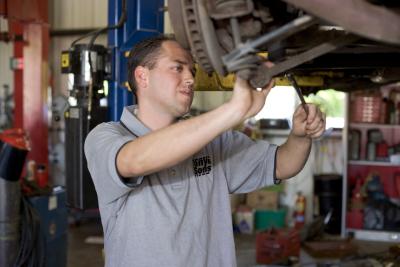
You need to inspect the brake lines on your Chevy pickup truck every six months. If there are any leaks, corrosion or any other damage in the lines, you need to remove them for replacement. The lines are separated into metal pipes and rubber hoses, and either part may need replacing at any time.
If you are removing the metal brake lines for replacement, make sure you have the correct type of replacement lines. You need steel brake lines from an auto parts store or your Chevy dealer's parts department--never use copper tubing. You can get prefabricated brake lines from either of these places, with the tube ends already flared and the fittings installed.
Raise the truck (securing it on jack stands works best), and remove the wheel corresponding to the brake line you are removing. You need two wrenches to separate the brake line from the rubber hose at the bracket. Use a flare-nut wrench on the fitting nut so you don't strip the ends of the nut, and hold the hose end with an open-end wrench so you won't twist the frame bracket. Disconnect the fittings at the other end as well to remove the metal line.
If you need to remove the rubber hose, there is a U-clip at the female fitting of the brake line on most Chevy pickup models. Remove this clip with a pair of pliers, pass the hose through the bracket and remove the bolts securing the hose brackets to the steering knuckle and upper control arm.
You will need the old brake line as a guide when replacing it, as the new pipe must be bent in the exact same way. Use a tubing bender to shape the brake line in this manner.
After you connect the new brake line by tightening the fitting nuts and/or installing the U-clip, you need to bleed the air out of whichever brake caliper the new brake line is connected to. With the master cylinder reservoir filled with fluid, attach a clear tube to the caliper's bleeder valve and submerge the other end in a container of fluid. Open the bleeder valve and have an assistant repeatedly press the brake pedal to remove air until the fluid flows cleanly out the tube. Top off the master cylinder after bleeding the brakes.